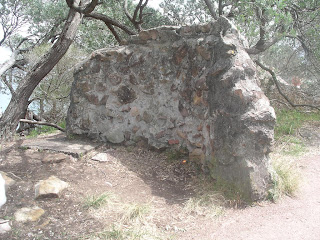The Worimi tribe consisted of the Grewerogal, Gampingal and Maiangal groups who lived on the waterfronts around the Port Stephens.
 |
| Signage for the Tomaree Coastal Walk from Tomaree Head to Fingal Bay |
 |
| View from Tomaree Head overlooking Xenith, Wreck and Box Beaches and out to the Final Bay Spit |
On the Tomaree Coastal Walk, mid-way along the track to Wreck Beach adjacent to the entrance from Jolleen Crescent, Shoal Bay, there is a significant local Aboriginal shell midden.
A midden is a mound made up of the remains of shells, fish bones, charcoal, the bones of mammals and sometimes tools. They are generally found at important sites where Aboriginal people have gathered. In coastal areas, they are found near places of good fishing or abundant shellfish, near rocky headlands and estuaries.[ Port Stephens - Great lakes Marine Park, Teacher Fact Sheet, Module 4 Sea and Country].
This midden is located on the steep incline up from the shoreline of Shoal Bay and has obviously been uncovered by the excavation of the fire trail which is the present day track. It extends over a large area.
It is also quite deep as indicated by the various layers which are evident in the photos below. It would have been laid down over a considerable period of time and would hold much Aboriginal history.
A midden is a mound made up of the remains of shells, fish bones, charcoal, the bones of mammals and sometimes tools. They are generally found at important sites where Aboriginal people have gathered. In coastal areas, they are found near places of good fishing or abundant shellfish, near rocky headlands and estuaries.[ Port Stephens - Great lakes Marine Park, Teacher Fact Sheet, Module 4 Sea and Country].
This midden is located on the steep incline up from the shoreline of Shoal Bay and has obviously been uncovered by the excavation of the fire trail which is the present day track. It extends over a large area.
It is also quite deep as indicated by the various layers which are evident in the photos below. It would have been laid down over a considerable period of time and would hold much Aboriginal history.
 |
| Aboriginal midden on the Wreck Beach track showing various layers |
 |
| A front-on view of the layered midden on the Wreck Beach track |
 |
| A closer view of the shells in the midden |
 |
| Aboriginal scarred tree - near Joleen Crescent, Shoal Bay |
********************************************************************************
The Nelson Bay, Port Stephens and Newcastle area is rich in early Australian history.
If you are interested in researching Australian history go to our website at :
http://www.historyservices.com.au/convicts.htm
All photos taken October 2012
Blog prepared by Mary McGuinness
http://www.historyservices.com.au/convicts.htm
All photos taken October 2012
Blog prepared by Mary McGuinness
Jollenn



















